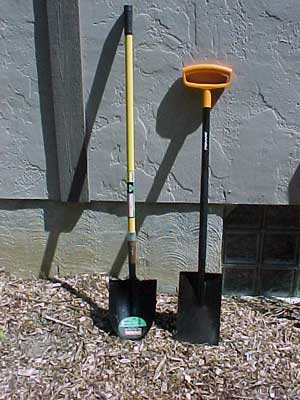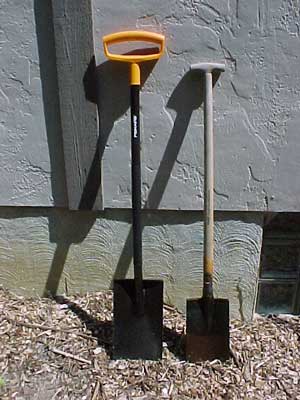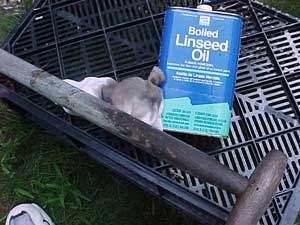 |
| © Jeff Ball |
| Shovel vs. Spade |
The spade is a more specialized digging tool, used for starting new gardens in lawns, edging lawns and garden beds, and digging ditches for drainage. Spades are particularly well-suited for cutting through roots and compacted soil when digging planting holes or turning beds. The spade is often used as the tool of choice for splitting up perennials and large clumps of ornamental grasses that have gotten to large for their space.
Design
A spade can have a long handle or a short handle. Its blade is usually rectangular with a flat straight edge on the bottom. Unlike the shovel, the blade is not rounded at the back, so it is not so valuable for lifting materials from one place to another.
 |
| © Jeff Ball |
| Two Spades |
Durability
Like shovels, most spades will have blades that are either “stamped” or “forged” steel. Forged is better than stamped. Some spade ads will talk about “tempered” and that is better than those with no tempering. If they talk about “gauge” in the advertisement, the lower number 14 is better than the higher number 16. The better spades have longer sockets where the handle is attached to the blade. Stainless steel looks nice and resists rust, but in the end is just a fancy spade that is very expensive.
Handle
Spades come with either a wooden (ash or hickory) handle or a fiberglass handle. Some handles are thicker than others. The wood is heavier but has a nice “feel” to some folks. The fiberglass is lighter and definitely stronger than the wood but doesn’t look as nice to some folks.
Comfort
Most folks will start off with a short handled spade. It gives you a better feel of the job being closer to the work. The long-handled spades give you more leverage in some instances, but most spades sold have short handles with the “D” handle.
Maintenance
A good spade deserves some maintenance to preserve its value over a long period of time. A spade is meant to be sharpened like an axe, which is why the bottom of the blade must be flat. Use a metal “bastard” file – a flat, double-cut file available at hardware stores. Clamp the spade in a vise or hold it firmly on a bench and holding the file at a slight angle, file the inside edge until it is shiny and sharp. Also see some examples of tool sharpeners in the file Garden Tool Sharpening Tools in Yardener's Tool Shed.
 |
| ©: Jeff Ball |
| Linseed Oil Protects Wood Handles |
The wooden handle can be oiled with linseed oil (used to care for baseball mitts) and should not be left out in the rain; ever. The blade should be cleaned off when dirt accumulates. Some yardeners keep an old pail filled with sand and about a quart of used automobile oil. As they come into the house, after using the spade, they dip the blade into the sand a few times to clean it off and give it a thin coat of oil to protect it from rust.

